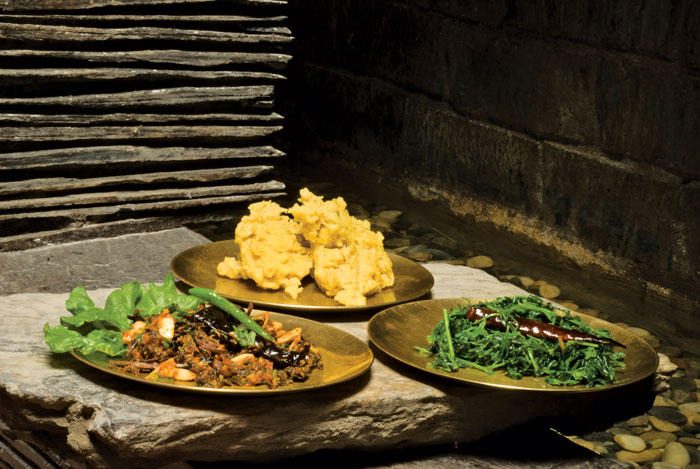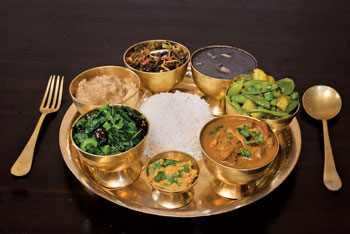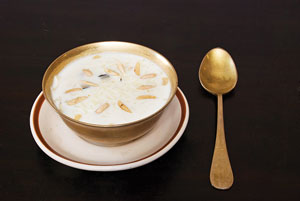
The ‘F’ in festivals, stands for food. Not just any food, but the kind which starts a small celebration in your mouth. While Dashain is ubiquitously celebrated my most communities in Nepal, slight differences in their festive food habits make the occasion all the more exciting.
Come Ashwin (September-October in the English calendar), the air all over Nepal is filled with festivity. It is the month of the biggest and longest festival. Celebrated for ten days, when Goddess Durga took the form of Mahirasurmardini defeating and beheading Mahishasura, the buffalo demon to save the world from evil. Being the biggest festival of Nepal, Dasain is a time for celebration, merrymaking, festivity, receiving and giving blessings, plenty of good food and drinks! Most people living away from their families, go back to their ancestral or parents home to observe this festival. In many ways, it is a festival that revives the family bonding. It’s a time when we all go lax on our dietary plans and indulge in scrumptious food the festivity offers irrespective of the different communities we belong to. Even our religious texts highlight the importance of good food-
‘When nourishment is pure, reflection and higher
understanding are pure, memory becomes strong.
When memory becomes strong, there is release
from all the knots of the heart.’ -Chandogya Upanishad
 The next best thing to eating food, is talking about it, and here writing about it! And who doesn’t like good food? So, let me take you through a Dasain culinary tour of some of the Nepali communities from the south to the north, to savour the festive relishes. This Dasain, you must indulge in the variety of food the festival offers!
The next best thing to eating food, is talking about it, and here writing about it! And who doesn’t like good food? So, let me take you through a Dasain culinary tour of some of the Nepali communities from the south to the north, to savour the festive relishes. This Dasain, you must indulge in the variety of food the festival offers!
Dasain being the most sought after festival of Nepal, sets out with the sowing of the jau or barley seeds for the special jamara, a tender grass offered to Goddess Durga on the first day called the Ghatasthapan. The people of the central terai region, the Maithili kshetra revere the Shakti, and believe that without the blessings of the shakti, nothing can proceed forward, and so Dasain is celebrated as a prime festival after Chhat. The eighth day or ashtami, is the day of offerings, large quantities of laddu and pedas are offered from early morning after which the temple is cleansed and pancha bali (offering of five different animals) is offered to the Rajdevi temple at Janankpur. This temple is one of the places with the largest number of animal offerings made by families during Dasain. After which non-vegetarian food is introduced to the festivity. Before that the food is strictly vegetarian, uncontaminated (chokho) for those observing the navratra fast.
Non vegetarian food in the form of fried meat and gravy are prepared. Cadi-badi, a variety of spiced curd with dumplings, taruwa or pan fried pakodas, lentil stuffed puris made from rice as well as wheat flour, kheer, laddu, pedas, gujiyas, malpuwa, are consumed in large amounts, shared with friends, relatives and specially married daughters and their families. The festive food is observed for the next three days, ashtami through Dashami - the main day of Dasain.
Moving north from the terai region is the hilly region, dominated by the Brahmins, Newars and to an extent by the Gurung community. Each one celebrates Dasain with a different fanfare. Brahmins traditionally form the priestly class and observe Dasain by celebrating Navaratri, nine days dedicated to the worship of the goddess Durga. Their celebration focus more on the ritual. Like other communities they offer the bhog or animal sacrifice of a ram on the night of the eighth day or ashtami called the kaalratri after the moon is clear in the night sky. The male head of the family or the performer of the rituals and women folk observe a fast for nine days eating only a pure vegetarian diet. Non-vegetarian food is introduced only on the ninth day, and the family relishes a wholesome variety of fried and curried meat, fresh vegetables, puri, kheer, malpuwa a variety of freshly made as well as preserved pickles or raddish, potatoes, cucumber served with selroti with their family and friends. Traditionally the Brahmins and the Maithili communities abstain from alcohol.
The Gurungs, originally lived in the Lamjung area of western Nepal and are specially known for their service in the army. Although a mixed community of Hindus and Buddhists, spread mostly in the hilly regions presently, they celebrate Dasain as their biggest festival. Besides worshipping the supreme Goddess Durga, they also worship the ancestral deities on nawami or the ninth day. Either a ram, cock, buffalo is traditionally offered in the Kot, a worship place specially established by the army. The offering is made by the mukhiya or the head of the village. Nowadays, offerings are made at temples and the meat is relished in the fried and curried form. The intestines are another delicacy relished as snacks with selroti and the jhilinge a speciality of the Gurungs. Preserved cucumber pickles, seasonal vegetables and meat is savoured with rice and millet whiskey. The tenth day is a big feast with married daughters and all younger ones in the family visiting the elders for blessings and receiving the tika. The Gurung tika is distinctively white in color and not the typical red. A mixture of rice grains and yogurt, because the red simrik powder was unavailable in the hilly regions where they lived earlier.
 The Newars, who claim to be the original dwellers of the Kathmandu valley call Dasain, ‘Mohini’ after the black tika made of soot which is worn by member of the same clan on the day of dasami. Similar to the other communities, Dasain starts with planting the jamara. However unlike other communities, they abstain from eating rice from the seventh day, considering it contaminated or impure. The Newar community is popularly known to spoil themselves with a rich variety of food, drinks and merrymaking, to the extent that they were unable to counter when Prithivi Narayan Shah attacked Kathmandu in 1768 on the night of festivity during Indra Jatra. They offer the cock, duck, ram, buffalo to Goddess Durga on the eighth and ninth day at various Shakti peethas and at temple of their tutelary diety. From the seventh day, they perform strict rituals and consume the samaya baji or an assortment of syabaji, chura, meat, fish, ginger and garlic, black soya, egg, wo, these are supposed to represent the five elements of nature. The evening meal on the eighth day is called Kuchi bhwye or a feast with two manas (portion) of chuira. The night meals are literal feasts: meat is prepared in more than 6-7 varieties accompanied with chiura, a variety of seasonal cooked vegetables, pulses, fresh pickles, a choice of locally brewed wine, beer or whiskey, pau (a sour juice made from lapsi), yogurt culminating the meal with fresh fruits and vegetables. The order of the serving is strictly followed to observe a scientific path facilitating digestion of the heavy meal. Traditionally the feasts before the tenth day, is shared only with family members. After the tenth day friend and other relatives are all invited to receive blessings and partake in the festivity.
The Newars, who claim to be the original dwellers of the Kathmandu valley call Dasain, ‘Mohini’ after the black tika made of soot which is worn by member of the same clan on the day of dasami. Similar to the other communities, Dasain starts with planting the jamara. However unlike other communities, they abstain from eating rice from the seventh day, considering it contaminated or impure. The Newar community is popularly known to spoil themselves with a rich variety of food, drinks and merrymaking, to the extent that they were unable to counter when Prithivi Narayan Shah attacked Kathmandu in 1768 on the night of festivity during Indra Jatra. They offer the cock, duck, ram, buffalo to Goddess Durga on the eighth and ninth day at various Shakti peethas and at temple of their tutelary diety. From the seventh day, they perform strict rituals and consume the samaya baji or an assortment of syabaji, chura, meat, fish, ginger and garlic, black soya, egg, wo, these are supposed to represent the five elements of nature. The evening meal on the eighth day is called Kuchi bhwye or a feast with two manas (portion) of chuira. The night meals are literal feasts: meat is prepared in more than 6-7 varieties accompanied with chiura, a variety of seasonal cooked vegetables, pulses, fresh pickles, a choice of locally brewed wine, beer or whiskey, pau (a sour juice made from lapsi), yogurt culminating the meal with fresh fruits and vegetables. The order of the serving is strictly followed to observe a scientific path facilitating digestion of the heavy meal. Traditionally the feasts before the tenth day, is shared only with family members. After the tenth day friend and other relatives are all invited to receive blessings and partake in the festivity.
The mountainous region of Nepal is dominated by the Sherpa and the Thakali community. The Thakalis traditionally lived in the Thak Khola, the high valley of the Kali-Gandaki River in western Nepal. Although they claim their prime religion to be Bon-po a form of shamanism, they are currently a mixed community of Buddhists, Hindus, and Shamanists. The Thakalis are known to be excellent business and tradesmen, thus migrating and assimilating local culture as part of their lifestyle. Like other Nepalese they celebrate Dasain, as an important festivals planting the jamara to commence the festival. Because they traditionally belonged to the mountainous region, they focus more on preserved pickles, especially made of cucumber called khalpi, and lapsi, selroti, varieties of meat, fried intestines and locally made sausages all served with fried chiura or furandana. The sausage has two varieties one stuffed with buckwheat flour called dhung and another with a mixture of spiced blood and flour called kathug. Fresh vegetables do not take the centre stage in Thakali festive food besides szechwan spiced fried potatoes. Locally made alcohol and beer is an important part of the festivity. Similar to other communities, relatives, friends are all a part of the festivity and merrymaking.
 Everybody in Nepal, from a young child to the elderly keenly look forward towards Dasain. Earlier, it was also a form of entertainment besides the festivity, now days when other sources of entertainment are galore, Dasain is still held sacredly as a time to relax, bond with family and make merry accompanied with lots of tasty food. Nepal, although a small country physically, is home to a large number of communities since it was the migrating ground form the north and south since ancient days. Hence there are approximately 125 different communities, living and celebrating various festivals through their respective cultures based on the availability of local resources.
Everybody in Nepal, from a young child to the elderly keenly look forward towards Dasain. Earlier, it was also a form of entertainment besides the festivity, now days when other sources of entertainment are galore, Dasain is still held sacredly as a time to relax, bond with family and make merry accompanied with lots of tasty food. Nepal, although a small country physically, is home to a large number of communities since it was the migrating ground form the north and south since ancient days. Hence there are approximately 125 different communities, living and celebrating various festivals through their respective cultures based on the availability of local resources.











